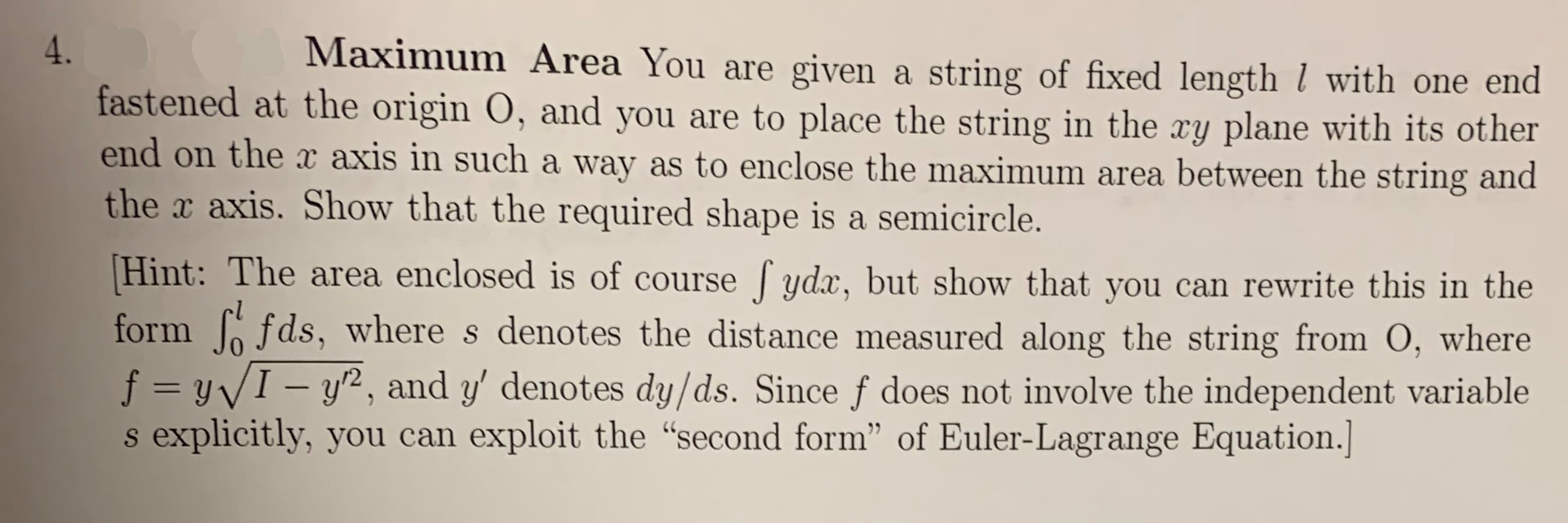4. Maximum Area You are given a string of fixed length l with one end fastened at the origin O, and you are to place the string in the ry plane with its other end on the x axis in such a way as to enclose the maximum area between the string and the x axis. Show that the required shape is a semicircle. Hint: The area enclosed is of course ydx, but show that you can rewrite this in the form fds, where s denotes the distance measured along the string from O, where f = yvI - y2, and y' denotes dy/ds. Since f does not involve the independent variable s explicitly, you can exploit the "second form" of Euler-Lagrange Equation.
4. Maximum Area You are given a string of fixed length l with one end fastened at the origin O, and you are to place the string in the ry plane with its other end on the x axis in such a way as to enclose the maximum area between the string and the x axis. Show that the required shape is a semicircle. Hint: The area enclosed is of course ydx, but show that you can rewrite this in the form fds, where s denotes the distance measured along the string from O, where f = yvI - y2, and y' denotes dy/ds. Since f does not involve the independent variable s explicitly, you can exploit the "second form" of Euler-Lagrange Equation.
College Physics
1st Edition
ISBN:9781938168000
Author:Paul Peter Urone, Roger Hinrichs
Publisher:Paul Peter Urone, Roger Hinrichs
Chapter28: Special Relativity
Section: Chapter Questions
Problem 13CQ: All galaxies farther away than about 50106ly exhibit a red shift in their emitted light that is...
Related questions
Question

Transcribed Image Text:4.
Maximum Area You are given a string of fixed length l with one end
fastened at the origin O, and you are to place the string in the ry plane with its other
end on the x axis in such a way as to enclose the maximum area between the string and
the x axis. Show that the required shape is a semicircle.
Hint: The area enclosed is of course ydx, but show that you can rewrite this in the
form fds, where s denotes the distance measured along the string from O, where
f = yvI - y2, and y' denotes dy/ds. Since f does not involve the independent variable
s explicitly, you can exploit the "second form" of Euler-Lagrange Equation.
Expert Solution
This question has been solved!
Explore an expertly crafted, step-by-step solution for a thorough understanding of key concepts.
This is a popular solution!
Trending now
This is a popular solution!
Step by step
Solved in 3 steps with 3 images

Recommended textbooks for you

College Physics
Physics
ISBN:
9781938168000
Author:
Paul Peter Urone, Roger Hinrichs
Publisher:
OpenStax College

Physics for Scientists and Engineers, Technology …
Physics
ISBN:
9781305116399
Author:
Raymond A. Serway, John W. Jewett
Publisher:
Cengage Learning

Physics for Scientists and Engineers: Foundations…
Physics
ISBN:
9781133939146
Author:
Katz, Debora M.
Publisher:
Cengage Learning

College Physics
Physics
ISBN:
9781938168000
Author:
Paul Peter Urone, Roger Hinrichs
Publisher:
OpenStax College

Physics for Scientists and Engineers, Technology …
Physics
ISBN:
9781305116399
Author:
Raymond A. Serway, John W. Jewett
Publisher:
Cengage Learning

Physics for Scientists and Engineers: Foundations…
Physics
ISBN:
9781133939146
Author:
Katz, Debora M.
Publisher:
Cengage Learning


College Physics
Physics
ISBN:
9781305952300
Author:
Raymond A. Serway, Chris Vuille
Publisher:
Cengage Learning

College Physics
Physics
ISBN:
9781285737027
Author:
Raymond A. Serway, Chris Vuille
Publisher:
Cengage Learning